| ‘ J-PARC News - May 2016 (Issue #133) |
| FY2016 Workshop 5. 23 for Fostering Safety Culture at J-PARC (May 20, Auditorium, Nuclear Science Research Institute) |
|---|
| To keep fresh the lessons of the radioactive material leak incident at the Hadron Experimental Facility on May 23, 2013, J-PARC holds a workshop every year to raise safety awareness of the staff members. This year, the workshop was held on May 20 with the auditorium of the Nuclear Science Research Institute as the main venue, and live TV links with KEK Tsukuba Campus and KEK Tokai Campus. Keiji Abe, principal researcher at the Safety Research Institute of West Japan Railway Company (JR West), was invited as a speaker, and he spoke on the topic of "Safety Efforts in Airlines and Railways." The workshop began with an overview by Dr. Naohito Saito, Director of the J-PARC Center, of safety measures taken after the incident three years ago, and the current safety situation at J-PARC. Mr. Abe spoke, based on his experiences after the crash of Japan Airlines Flight 123 in 1985, and the Amagasaki Rail Crash of 2005, that human error cannot be avoided, nevertheless we can prevent human error leading to an accident by improving prediction, recognition, and recovery capabilities. At the end, Dr. Ishii, the Deputy Director of Safety at J-PARC, spoke on the importance of not allowing social injuries which can lead to a loss of trust, and major injuries which can threaten human life. He also discussed J-PARC's basic approach toward future efforts of "making safety activities cheerful and fun." |
|
| "Investigating Neutrons at J-PARC" (article featured in June issue of Nikkei Science) |
|---|
| Precision measurements of neutron life (about 15 minutes) are being carried out with the Neutron Optics and Fundamental Physics (NOP) set up on neutron beamline BL05 of the Materials and Life Science Experimental Facility (MLF). Neutron life plays an important role in predicting the elemental composition of the universe, but there is some dispersion in the value, and overseas researchers are also trying to measure it precisely. Experiments are being conducted at NOP using a new measurement technique, and an article on this research was featured in the June issue of Nikkei Science. |
| |
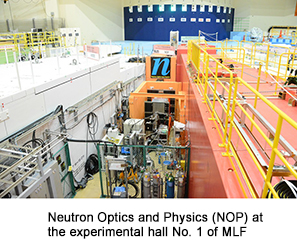
 * Click here to enlarge. * Click here to enlarge. |
| |
| £to Page Top |
| |
|
| KEK-PIP Advisory Committee (May 22-23, KEK Tsukuba) |
|---|
| An advisory committee to provide advice on KEK's Project Implementation Plan (PIP) for research planning was held on May 22-23, with 12 experts invited from both inside and outside Japan. The committee discussed four projects relating to J-PARC: the COMET-II experiment; the J-PARC accelerator enhancement and Hyper Kamiokande plan; expansion of the Hadron Experimental Facility; and H-line construction and planning of a g-2/EDM experiment plan for the muon facility. |
| |
| £to Page Top |
| |
|
| J-PARC Neutron Life Science Research Meeting (May 17-18, J-PARC Research Building, other locations) "The Current State and Future of Neutron Use in Life Science" |
|---|
| This research meeting was jointly organized by the J-PARC Center and the National Institutes for Quantum and Radiological Science and Technology (QST) to deepen discussion of the degree to which research using neutron scattering contributes to life science, and its possibilities for the future. The meeting was attended by about 45 researchers being active on the front line in this field. Reports on the current situation of neutron use were made by Kyoto University, QST, Ibaraki University and others, and there were in-depth discussion of the deuteration laboratory and large protein neutron diffractometer whose installation is planned for the MLF. |
| |
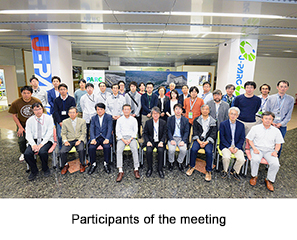
 * Click here to enlarge. * Click here to enlarge. |
| |
| £to Page Top |
| |
|
| Exhibition at the G7 Science & Technology Ministers' Meeting in Tsukuba, IbarakiiMay 15-21, Tsukuba International Congress Center) |
|---|
| A meeting of the science and technology ministers of seven advanced countries (G7) was held in Tsukuba Science City, and the J-PARC Center exhibited jointly with KEK at a special exhibition for the meeting. During the meeting on the 15th-17th, the exhibition booth was visited by persons connected with the meeting and participants in a commemorative symposium. After the commemorative symposium on the 15th, the ministers from each country visited the booth, and Naohito Saito, Director of the J-PARC Center, introduced the research being conducted at J-PARC, and J-PARC's system for international cooperation. After the meeting period was finished, the exhibition was opened to the public until the 21st. |
| |
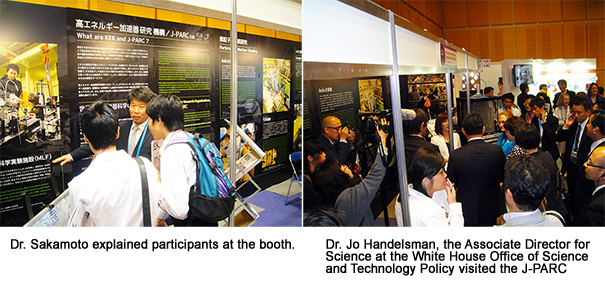
 * Click here to enlarge. * Click here to enlarge. |
| |
| £to Page Top |
| |
|
| Facility Updates |
|---|
| Experimental Facilities |
| At the Materials and Life Science Experimental Facility, a new spectrometer has been installed in the S1 experimental area of the slow muon beamline currently under construction in Experimental Hall #1. The first muon beam was successfully extracted at this beamline at the end of October 2015, and since then tasks like beam adjustment have been underway. The newly installed spectrometer has the exact same design as the one currently operating in the D1 experimental area, and it measures the properties of bulk samples by using muon spin rotation (ΚSR). Going forward, we will share know-how and other findings obtained through the development of spectrometers in these two experimental areas, and we plan to carry out research on element strategies (electronic materials) and other themes while working to upgrade the positron detector (Kalliope). * For details on the positron detector (Kalliope), see J-PARC News No. 95.http://www.j-parc.jp/en/news/2013/J-PARC_News-e1302.html |
| |
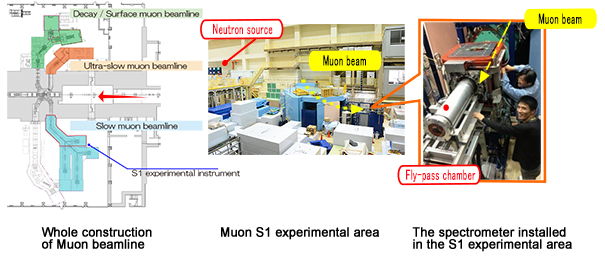
 * Click here to enlarge. * Click here to enlarge. |
| |
| £to Page Top |
| |
|
| Science Cafe for Science and Technology Week (April 24, Science Museum in Kitanomaru Park, Tokyo) "Neutrinos Transform Themselves!? - The Nobel Prize-Winning Research that has Changed the World -@" |
|---|
| At a Science Cafe for the 57th Science and Technology Week organized by the Ministry of Education, Culture, Sports, Science and Technology, J-PARC public relations advisors Dr. Sakamoto and Dr. Uzumaki gave a presentation on the topic of neutrinos. There was a higher-than-expected turn-out of 34 attendees with a wide range of ages, from elementary school to adults, and they packed the venue. The riddle of how neutrinos in flight change (oscillate) into another type and the relationship of this phenomenon to mass were explained using a model made with superballs to color code for the three types of neutrinos, quizzes throughout the talk and other teaching aids. The children were fascinated by the model?when they put in a ball from the back side of the earth, it transformed itself and came out another color at the Super Kamiokande. When the Science Cafe was over, they even tried to do the same thing with their own hands. Like much elementary particle research, this experiment is difficult to understand, but the presentation by J-PARC seems to have made it a little more accessible. |
| |
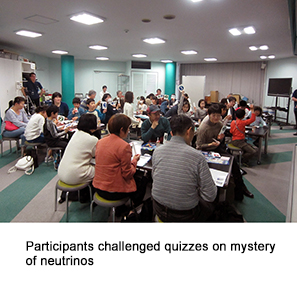 |
| |
| £to Page Top |
| |
|
| Sumi-E Painting (April 28, Advanced Science Research Center Building) |
|---|
| The J-PARC Center and the International Affairs Department of JAEA hold various trial lessons to strengthen interaction among people working in JAEA, J-PARC, CROSS and QST. This time, a class was held on sumi-e, a Japanese traditional painting technique. For most of the participants, this was their first encounter with sumi-e, and they painted various subjects while looking at a text. Subjects included rabbits, frogs, grapes, and goldfish, and the participants each had their own unique styles. The paintings came out so beautifully, one would not think they were first efforts, and everyone seemed to enjoy sumi-e. |
| |

 * Click here to enlarge. * Click here to enlarge. |
| |
| £to Page Top |
| |
|
| Looking for participants to attend "Neutrinos: The Link between Space and Elementary Particles," a lecture meeting in commemoration of Prof. Takaaki Kajita's Nobel Prize in Physics. (Application period: May 16 to June 15) |
|---|
| A lecture featuring Professor Takaaki Kajita, Director of the Institute for Cosmic Ray Research, University of Tokyo, and 2015 Nobel Laureate in Physics, will be held on July 16. The meeting will be jointly sponsored by the J-PARC Center and Tokai Village, and held at the Tokai Culture Center on July 16. It is scheduled to include talks by Prof. Kajita, an experimental scientist, and the theoretical scientist Professor Hitoshi Murayama, Director of the Kavli Institute for the Physics and Mathematics of the Universe, University of Tokyo. There will also be a mingling session including the J-PARC researchers who are carrying out the T2K experiment. This event will be in Japanese only. (We have been accepting applications to participate since May 16. The deadline for applications is June 15. Participants will be selected by drawing.) |
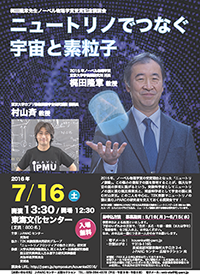
 * Click here to enlarge. * Click here to enlarge. |
| |
| £to Page Top |
| |
|
©2016 J-PARC Center. All rights reserved.
|
|